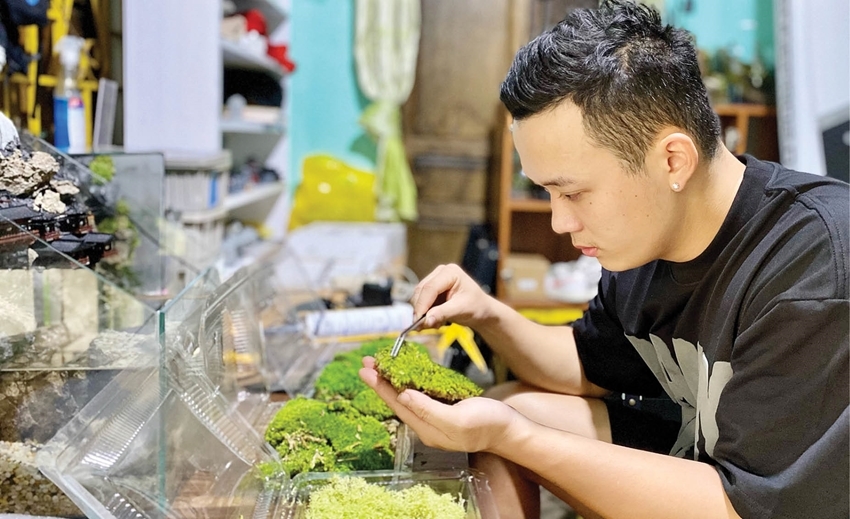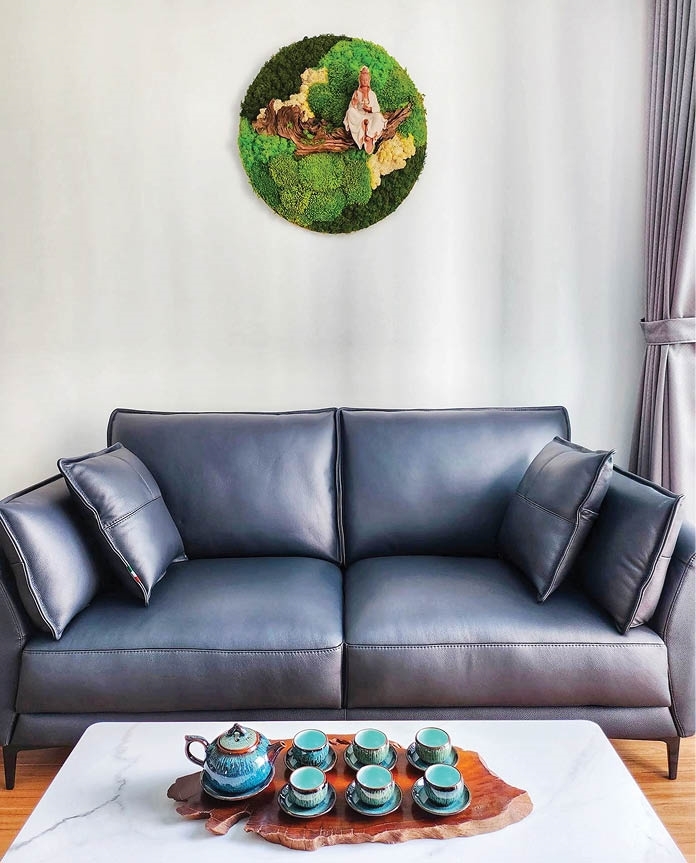 |
| The moss being meticulously cleaned |
“Immortal”
In the wild, large patches of green moss are often found in mountainous, humid areas or forests with high humidity. Doing no harm to plants grown together and creating humidity, moss is always chosen as a foundation for miniature landscapes and aquatic plants. However, with artistic moss paintings, green moss patches are not simply selected, they also need to be meticulously processed before being integrated into the painting.
According to Phuoc Son, artistic moss paintings will normally be hung as decoratives in the living room or large spaces (usually bright, dry ones). Therefore, it will be quite inconvenient to care for and sustain them in case the mosses’ natural state is kept intact. “As a result, the mosses integrated into paintings must be carefully processed so that the moss still retains its color and shape even without care for a long time. These are called immortal or conservation mosses,” said Mr. Phuoc Son.
Immortal moss is the one that has been cleaned of mud, insects or mold. After being cleaned, the moss clusters will be specially processed to make the cells of the moss hibernate and not decompose anymore. Thence, Phuoc Son can tile, integrate, mix, and combine moss with other materials to create unique paintings.
 |
| Moss paintings with peaceful natural green patches bringing a sense of peace |
Normally, artistic moss paintings will be divided into two types, including minimalist and modified moss paintings. Regarding minimalist moss painting, it only uses very few materials. Normally, over 90% of the area of the painting will be filled with moss clusters. “Therefore, to make the painting vivid and eye-catching, I have to take advantage of the shape and color of the moss to create layers as well as visual effects for the painting,” said Mr. Son.
“Make a big difference” to moss
Take Weeping moss as an example. The typical characteristic of this type of moss is that its canopy is quite drooping, so it is often used to create softness for paintings. As for Reindeer Moss, its spongy texture, branched fibers and oblong shape of moss clusters are very suitable for creating clusters and lumps of moss in paintings.
Phuoc Son added: “No matter what type of moss painting, the ability to mix and match the moss with the painting to enhance the beauty of the moss, the harmony and attraction of the overall layout and the logic of each small detail is extremely important.” Therefore, along with minimalist moss paintings, when mixing and combining with other materials to create modified moss paintings, the understanding of the materials and having an aesthetic eye are essential.”
The softness of mosses’ shape and bright color is suitable for rough, sedimentary materials such as gravel, soil, rocks, tree roots, driftwood, and fossil bones of all kinds. Consequently, these are the materials often chosen to mix and match with moss in variation paintings.
But no matter what choice it is, nature is still an endless inspiration for Phuoc Son to complete his paintings. He said: “The nature of my job means that I often travel to streams and wet mountain areas. Traveling helps me gain more knowledge about moss, plants, and animals. At the same time, it gives me energy and inspiration to create different moss paintings.”
Perhaps, that is the reason why Son is meticulous and skillful to “integrate” his inspirations and ideas into the paintings whether with small ones ranging from a few dozen centimeters to large paintings. When looking at moss paintings, what customers feel is always a sense of comfort and peace with the green patches.
Ms. Thuy Khuyen, a female customer who bought moss paintings, said: “I’m living in an apartment in Ho Chi Minh City, so my living space is quite cramped. To make matter worse, my children are quite young. Therefore, when I bought the painting, I was very happy. The living room now becomes more beautiful, bright, comfortable and peaceful, and my children can also see the moss without having to take care of it.”
Photos: Phuoc Son – Tue Lam
